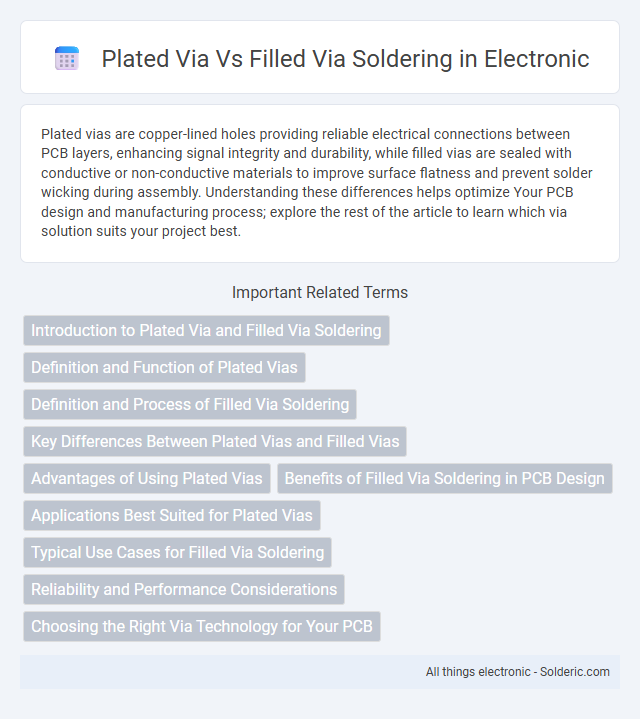Plated vias are copper-lined holes providing reliable electrical connections between PCB layers, enhancing signal integrity and durability, while filled vias are sealed with conductive or non-conductive materials to improve surface flatness and prevent solder wicking during assembly. Understanding these differences helps optimize Your PCB design and manufacturing process; explore the rest of the article to learn which via solution suits your project best.
Comparison Table
| Feature | Plated Via | Filled Via Soldering |
|---|---|---|
| Definition | Copper-coated hole connecting PCB layers | Via filled with solder before plating |
| Electrical Conductivity | High, consistent copper path | Enhanced with solder fill for improved conduction |
| Thermal Performance | Moderate, depends on copper thickness | Better heat dissipation due to solder fill |
| Mechanical Strength | Good, copper plating adds durability | Higher strength, solder fill adds rigidity |
| Cost | Lower manufacturing cost | Higher due to additional solder filling process |
| Use Cases | Standard PCB interlayer connection | High-power, high-reliability applications |
| Reliability | Good under normal conditions | Improved under thermal/mechanical stress |
Introduction to Plated Via and Filled Via Soldering
Plated vias are hollow copper-lined holes that electrically connect different layers of a printed circuit board (PCB), ensuring signal integrity and mechanical stability. Filled via soldering involves injecting conductive or non-conductive material into these vias before soldering to enhance structural strength, prevent solder wicking, and improve thermal performance. Your choice between plated and filled via soldering impacts PCB reliability, manufacturing complexity, and thermal management depending on the application's requirements.
Definition and Function of Plated Vias
Plated vias are small, copper-lined holes that electrically connect different layers of a printed circuit board (PCB), enabling seamless signal transmission and power distribution. In contrast to filled vias which are solid or resin-filled for structural support or thermal management, plated vias primarily ensure reliable electrical conduction while maintaining board integrity. Your PCB design's performance often depends on the precision and quality of these plated vias for optimal multilayer connectivity.
Definition and Process of Filled Via Soldering
Filled via soldering involves filling PCB vias with conductive or non-conductive materials before the soldering process to enhance electrical performance and mechanical stability. The process entails injecting epoxy or conductive paste into the vias, followed by curing and soldering, which creates a solid, flat surface ideal for component placement and heat dissipation. This method is critical for high-density interconnects and improves reliability by preventing solder wicking and ensuring consistent electrical connectivity.
Key Differences Between Plated Vias and Filled Vias
Plated vias feature a thin copper coating lining their walls, facilitating electrical connectivity between PCB layers while maintaining hollow interiors for solder flow; filled vias, however, are completely filled with conductive or non-conductive material to provide enhanced structural integrity and eliminate voids. Filled vias improve thermal management and reliability in high-density PCB designs by preventing solder wicking and enabling smoother surface finishes, whereas plated vias are primarily used for standard interlayer connections. The choice between plated and filled vias impacts manufacturing complexity, electrical performance, and mechanical strength in circuit board assembly processes.
Advantages of Using Plated Vias
Plated vias offer superior electrical conductivity and mechanical reliability due to their uniform copper coating, which enhances signal integrity and reduces resistance in multilayer PCBs. This method ensures robust thermal performance and prevents issues like voids or weak joints common in filled via soldering. Your designs benefit from improved durability and consistent quality, essential for high-frequency and high-density applications.
Benefits of Filled Via Soldering in PCB Design
Filled via soldering enhances PCB design by providing improved structural integrity and reliable electrical connectivity compared to plated vias. This technique reduces the risk of solder wicking, minimizes voids within the via, and ensures consistent thermal conductivity critical for high-frequency and high-power applications. Filled vias also contribute to a smoother surface finish, facilitating more efficient assembly and reducing potential solder joint failures in multilayer boards.
Applications Best Suited for Plated Vias
Plated vias are best suited for complex, multi-layer printed circuit boards (PCBs) requiring reliable electrical interconnections between layers in high-density applications such as smartphones, aerospace electronics, and medical devices. These vias provide consistent conductivity and mechanical strength, essential for sophisticated signal routing and power distribution in advanced telecommunications and computing systems. Unlike filled vias with solder, plated vias offer superior thermal dissipation and long-term durability, ensuring optimal performance in high-reliability environments.
Typical Use Cases for Filled Via Soldering
Filled via soldering is typically used in high-reliability electronic devices where enhanced structural integrity and thermal management are critical, such as in aerospace, military, and high-performance computing applications. This technique ensures void-free vias that improve heat dissipation and electrical conductivity, which is essential for high-density interconnect (HDI) printed circuit boards (PCBs) and multilayer designs. Filled vias also prevent solder wicking during component assembly, enabling robust surface mount technology (SMT) and fine-pitch component placement.
Reliability and Performance Considerations
Plated vias offer superior reliability due to their copper lining, ensuring consistent electrical connectivity and minimizing the risk of voids or cracks during thermal cycling. Filled vias, whether conductive or non-conductive, enhance performance by providing mechanical support and preventing solder wicking, which is crucial for high-density and high-frequency PCB designs. When designing your board, choosing plated vias with proper filling can optimize both electrical performance and long-term durability under mechanical and thermal stress.
Choosing the Right Via Technology for Your PCB
Plated vias offer superior electrical conductivity and mechanical strength due to their copper lining, making them ideal for high-density multilayer PCBs requiring reliable signal integrity and thermal management. Filled vias, often solid or resin-filled, enhance flatness and prevent solder wicking during assembly, which is crucial for controlled impedance and fine-pitch component placement in HDI designs. Selecting the appropriate via technology depends on factors like PCB complexity, layer count, signal frequency, and manufacturing constraints, ensuring optimal performance and cost-efficiency.
Plated via vs filled via soldering Infographic

 solderic.com
solderic.com